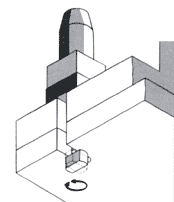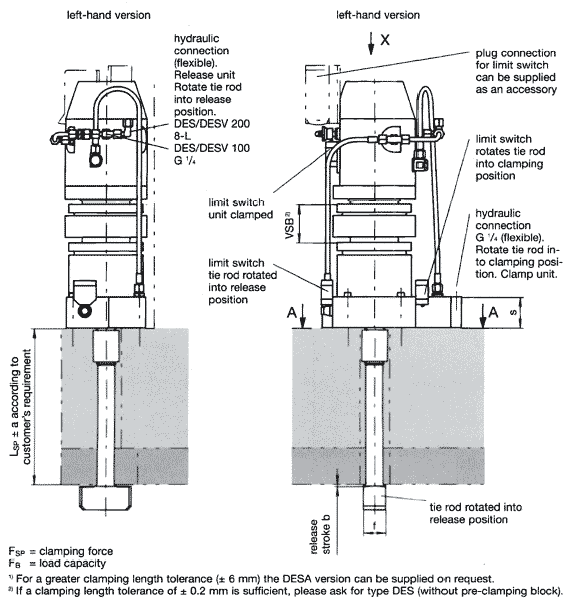DESV
Hydro-Mechanical Turn Clamp

Area of application
The hydro-mechanical turn-clamp unit type DE8V is designed for medium-sized and large presses exerting a force of ca. 500 tons and upwards. It is particularly suitable for top die clamping and for internal die clamping with multiple action presses.
The clamp unit is installed rigidly on the ram ledge. Alternatively, installation in the surface of the ram or bed is possible.
Its use requires dies that have lock plates or clamping edges with a U-recess.
Mode of operation
After a 90° rotation of the tie rod into the clamping position, a hydraulically actuated mechanically locking toggle mechanism transmits its clamping force to the tie rod.
Whereas the clamping force is developed mechanically, the rotary movement of the tie rod is produced hydraulically. The tie rod pinion rotates over a toothed rod unit, after a maximum 90° rotary movement, the tie rod reaches the clamping position. In this position, an edge control bore releases the hydraulic pressure to the clamping cylinder which actuates the toggle mechanism.
In the clamping position, automatic mechanical locking is carried out, and this can only be released by means of hydraulic pressure when unclamping.
Movement sequence for securing the slide:
- 90° rotation of the tie rod
- Clamping stroke of the tie rod (release of the slide in reverse order)
Distinguishing features
The clamp unit is fitted with the well-proven Optima toggle mechanism. In this system, the clamping force required is transmitted by mechanical components which are actuated by low hydraulic pressure during the clamping or release process. By so doing, the clamping force is independent of the compressibility of the pressure medium, operating temperatures and line losses.
The clamping force is continuously and directly monitored by the patented Optima "Aktivator". For this to function, there must not be any hydraulic pressure on the clamp unit. In this type of control, the clamp units are connected to the machine control system via electrical switches (precision limit switches) and in the event of irregularities, bring the machine to a standstill. In this clamping system, the tie rod projects from the surface of the ram or bed when unciamped. Due to the standard fitting with a pre-clamping block, die thickness tolerances up to ±0.5 mm are permitted.
Electrical control of the following functions (switches):
- Tie rod rotated into the unclamping position and released (S5)
- Continuous monitoring of clamping force (S6)
- Tie rod rotated into clamping position (S7)
Advantages
- Mechanical self-locking
- Maximum safety due to continuous monitoring of clamping force by means of the "Aktivator"
- Central control
- Hydraulic pressure only necessary during the clamping or release process
- High mechanical load capacity.
Construction
The clamp unit has a forged and gunmetal finish tie rod. The individual components of the toggle mechanism are made of hardened steels.
The clamp unit is secured by four bolts, of strength class 10.9 (not included). The thread dimension depends on the type (see technical drawing).
Technical data
| Type | DESV 100 | DESV 200 | |
| Nominal clamping force | kN | 100 | 200 |
| Set pressure | bar | 100 | 100 |
| Max. load capacity | kN | 125 | 250 |
| Max. operating pressure (min. set pressure + 20 bar) | bar | 140 | 140 |
| Release stroke | mm (ca.) | 3.5 | 3.5 |
| Die thickness tolerance | mm | ± 0.5 | ±0.5 |
| Oil volume required (each process) clamping | cm3 | 76 | 144 |
| Oil volume required (each process) release | cm3 | 76 | 144 |
| Delivery rate per unit* | l/min. | 1.0-1.5 | 1.5-2.0 |
| Weight | kg (ca.) | 48 | 68 |
| Hydraulic connections | see drawing | ||
| Max. operating temperature | °C | 70 | 70 |
| Pressure medium | Hydraulic oil DIN 51524 - HLP (ISO DIN 51519) |
||
| Viscosity | 25 - 60 cST/40°C | ||
| Filter | 20 - 25 µm | ||
*If a pump with a higher delivery rate than necessary is used, the oil flow must be reduced
by means of flow regulating valves or oneway restrictors.
Precision position switches
| Switching function: | single-pole change-over snap-action contact |
| Supply voltage: | 250 V AC |
| Switching capability: | 2A/230 V AC
5A/24 V DC |
| Contacts: | screw connection |
| Cable lead-in: | armoured cable 9 |
For a water- and oil-tight installation, we
recommend cable screw joints, in conjunction
with a protective sleeve.


| Type | FSP [kN] |
FB [kN] |
A |
a1) | b ca. |
c | d | e | f | g | h | i |
| DESV 100 | 100 | 125 | 390 | ±0.5 | 3.5 | 80 | 30 | 32 | 36 | 130 | 91 | 119 |
| DESV 200 | 200 | 250 | 485 | ±0.5 | 3.5 | 98 | 45 | 32 | 42 | 155 | 100 | 162 |

| k max |
m | n | o min |
p | r max |
s | t | u | w | x | y | z | Weight [kg] |
| 112 | 125 | 92 | 75 | 38 | 50 | 50 | M8 | 92 | 108 | 40 | 20 | 162 | 48 |
| 114 | 150 | 107 | 90 | 49 | 70 | 60 | M8 | 125 | 100 | 50 | 32 | 166 | 68 |
